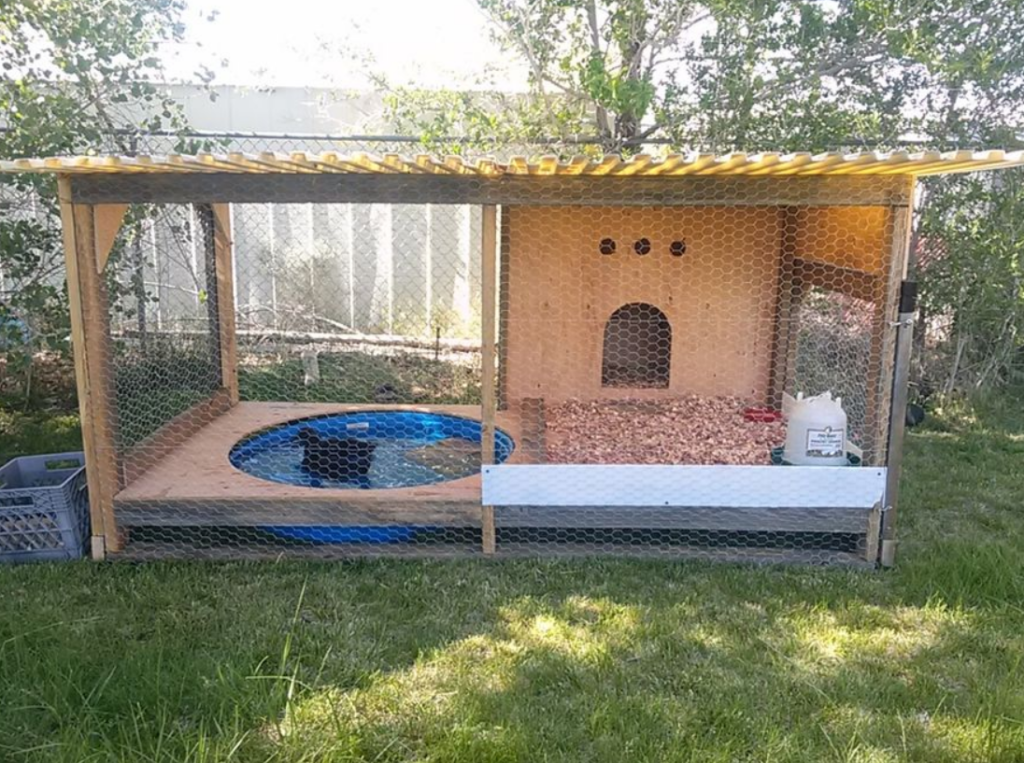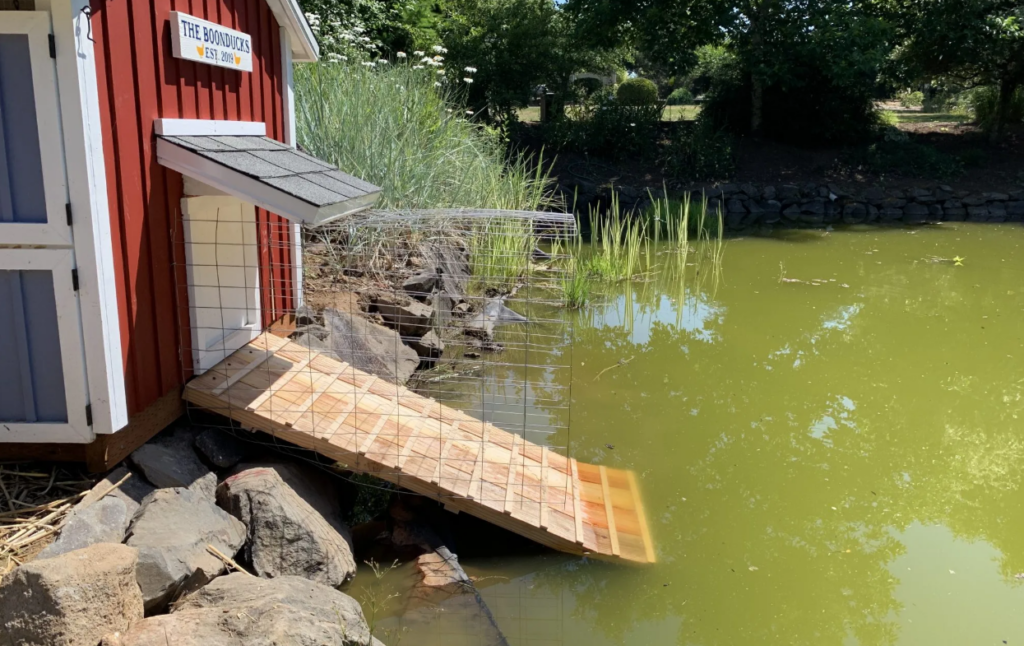Keeping ducks happy and safe starts with the right setup, and these DIY duck enclosure ideas offer plenty of clever ways to make that happen. A good enclosure isn’t just about fencing—it’s about giving your ducks a secure, comfortable space where they can roam, rest, and splash around freely.
These ideas range from simple, budget-friendly builds to more detailed designs, all tailored for backyard duck enthusiasts who enjoy a hands-on project. With a little creativity and planning, you can create an enclosure that fits your space, keeps predators out, and makes daily duck care easier and more enjoyable.
1. Backyard Duck Coop with Attached Run
Creating a backyard duck coop with an attached run is a fantastic way to give your ducks both shelter and plenty of room to roam. The coop itself should be sturdy and weather-resistant, offering a cozy space for the ducks to sleep and lay eggs, while the attached run provides a safe outdoor area for them to wander, forage, and enjoy fresh air. This type of setup is perfect for those with limited space but still want to ensure their ducks get enough exercise and freedom.
To build the perfect coop, start by ensuring the coop is well-ventilated, with enough space for each duck to have its own personal area. Add roosting bars inside the coop, and ensure the floor is easily cleaned. The run should be securely enclosed with strong fencing and have ample room for ducks to stretch their wings. Make sure both areas are accessible for cleaning and maintenance while also protecting the ducks from predators.

2. A-Frame Duck House
An A-frame duck house is a charming, efficient design that provides your ducks with a secure and well-ventilated shelter. The A-frame structure allows for a sloped roof, which encourages water to drain off easily, preventing leaks and keeping the ducks dry. This style is particularly advantageous in areas with heavy rainfall, as it keeps the interior of the house dry and well-ventilated. Its compact size makes it a good choice for smaller backyards or even mobile setups, giving your ducks a cozy, weatherproof retreat.
When constructing the house, focus on ensuring the A-frame is tall enough for ducks to comfortably stand and move around. Inside, add bedding such as straw or hay for warmth and comfort. You can also integrate an attached run for the ducks to explore during the day. The lightweight design of this type of house makes it easy to move to fresh areas of grass if needed, promoting healthy grazing for your ducks.

3. Movable Duck Tractor
A movable duck tractor offers your ducks a unique way to enjoy fresh pasture while staying safe from predators. This portable shelter allows you to move your ducks around the yard, giving them access to new areas of grass and insects daily. The tractor design is essentially a small, enclosed structure with wheels, making it easy to shift to different spots without requiring a lot of effort. This is an ideal choice for people looking to provide their ducks with fresh food and exercise while also maintaining a clean and healthy living space.
To build the perfect movable tractor, ensure it has secure, predator-proof walls made from sturdy materials like wire mesh. The tractor should also feature a comfortable space for the ducks to sleep, rest, and nest. For extra convenience, add a small door or ramp for the ducks to enter and exit, and keep the structure light enough for easy relocation. By rotating the tractor, you help control pests in the yard while giving your ducks a chance to enjoy different parts of the land.

4. Repurposed Shed Duck Shelter
A repurposed shed makes for a budget-friendly and practical duck shelter. By transforming an old shed, you can create a spacious, durable, and easily customizable home for your ducks. The structure already offers a solid framework that can be adapted to suit the needs of your feathered friends. With some basic modifications, like adding ventilation, secure doors, and appropriate flooring, a repurposed shed can provide a cozy, dry space for ducks to nest, rest, and sleep, while also offering ample room for movement.
When converting the shed, make sure to add sturdy fencing around the perimeter for the ducks to safely explore. Interior partitions can be used to create designated areas for nesting and sleeping. You may also want to ensure that the shed has adequate lighting and is well-ventilated to keep the ducks comfortable year-round. With a few enhancements, your repurposed shed can easily become a perfect duck haven that also saves you money.

5. Duck House with Kiddie Pool Pond
For ducks that love to swim and splash around, a duck house with a kiddie pool pond is a delightful solution. This setup includes both a cozy, secure shelter for resting and a small pond area where ducks can enjoy some water time. Ducks are naturally attracted to water, and a kiddie pool allows them to engage in their natural behaviors like paddling and dipping their heads, which is important for their well-being. The pond also helps with the ducks’ hygiene as they use it to clean themselves.
To create this setup, place the kiddie pool in an area that allows easy access to the ducks but also ensures it’s easy to clean and drain. The duck house should be well-insulated with soft bedding, and the space should be large enough to accommodate several ducks comfortably. The combination of water and shelter offers the ducks both relaxation and play, making it an ideal setup for those who want to keep ducks happy and healthy.

6. Pallet Wood Duck Pen
A pallet wood duck pen is a great way to recycle materials while creating a functional space for your ducks. Pallets are easy to source, inexpensive, and can be used to build sturdy walls and flooring for a simple yet effective pen. The open slats of the pallets provide ventilation, while the sturdy construction ensures the ducks are secure from predators. Plus, pallet wood gives the pen a rustic, natural look that blends well into backyard environments.
For an ideal setup, stack the pallets to create the walls and flooring of the pen, ensuring there are no gaps where predators can sneak through. Use chicken wire or hardware cloth to further reinforce the structure and secure it. Add a roof for weather protection, and don’t forget to provide comfortable bedding and a water source for the ducks. The simplicity of a pallet wood pen makes it easy to customize and adapt to your space, while also being a cost-effective solution.

7. Floating Duck House
If you’re looking for a creative and functional way to house your ducks, a floating duck house might be the perfect solution. This design involves creating a small, buoyant house that floats on water, offering a safe, dry space for ducks to rest while enjoying the natural beauty of a pond or lake. Floating houses can help keep ducks safe from land predators while allowing them to indulge in their love of water. The floating platform can be anchored to ensure the house stays in one location while still allowing ducks to freely come and go.
Building a floating duck house involves constructing a waterproof, lightweight structure that can easily float on the water’s surface. You can use foam boards, plastic barrels, or other buoyant materials to keep the house afloat. Inside, add bedding and nesting areas for the ducks, and consider including an easy-to-reach ramp or ladder for the ducks to climb up and access the house. This setup combines both functionality and the freedom ducks need to thrive in a natural environment.

8. Duck Enclosure with Garden Integration
Incorporating your ducks into your garden with a duck enclosure is a wonderful way to combine their habitat with your plants. The ducks will enjoy the opportunity to forage through the garden, eating pests and helping to fertilize the soil. In return, the garden provides them with fresh greens and natural entertainment. To keep everything organized, build a secure enclosure that gives your ducks access to specific areas of your garden while protecting your plants and flowers from damage.
The enclosure should be large enough for the ducks to move freely, with a sturdy fence around the perimeter to prevent escapes. Consider using raised beds in your garden to protect delicate plants while letting ducks access areas for foraging. By integrating the ducks into the garden, you create a symbiotic relationship where both your plants and ducks benefit. Make sure there’s always a safe water source and adequate shelter within the enclosure for the ducks to retreat to.

9. Greenhouse-Style Duck Coop
A greenhouse-style duck coop blends the practicality of a traditional coop with the benefits of a greenhouse, offering a bright, airy environment for your ducks. This setup uses clear polycarbonate or plastic panels for the walls, allowing sunlight to flood the interior, which is great for both the ducks and any plants you choose to grow. The natural light keeps the ducks warm during cooler months, and the airy space prevents the coop from feeling cramped. It’s a wonderful way to integrate some greenery into your ducks’ environment while giving them plenty of room to roam.
When setting up a greenhouse coop, ensure the structure is large enough for the ducks to move around comfortably. Inside, provide bedding, roosting bars, and nesting boxes for the ducks. You can also add some plants that are safe for ducks, creating a more natural and pleasant habitat. This type of coop is easy to maintain, keeps ducks cool in the summer, and provides ample natural light in the winter.

10. Raised Duck House with Ramp
A raised duck house with a ramp is a smart design choice, especially for those looking to create a dry, predator-proof space for their ducks. The raised platform keeps the ducks off the ground, protecting them from potential flooding, wet conditions, and pests. The addition of a ramp makes it easy for the ducks to access their elevated shelter, while also promoting better airflow and ventilation underneath the house. This design is especially useful for damp or flood-prone areas, where it’s important to keep the ducks dry and secure.
Building a raised duck house involves ensuring the structure is stable and high enough to keep the floor dry. The ramp should be wide enough for the ducks to walk up comfortably and securely. Inside, you’ll need to add plenty of soft bedding and nesting boxes. This setup not only provides the ducks with a safe and dry environment but also offers easier cleaning and maintenance for the owner.

FAQs
1. What’s the best size for a DIY duck enclosure?
The size of your duck enclosure should depend on the number of ducks you plan to keep. A general rule of thumb is to give each duck at least 4-6 square feet of indoor space and 10-15 square feet of outdoor space. Ducks love to roam and swim, so the more space, the happier they’ll be!
2. Do ducks need a roofed enclosure?
Yes, it’s a good idea to have a roof or overhead cover in your duck enclosure, especially if you live in an area with predators or lots of rain. A roof helps keep them safe from predators like hawks or raccoons and provides shelter from bad weather. A simple roof made of wire mesh or a sturdy tarp will do the trick.
3. How should I build the flooring of the enclosure?
Ducks tend to get messy, so flooring should be easy to clean. You can use materials like gravel, sand, or wood chips that allow for good drainage and won’t get too slippery. Adding straw or hay for bedding can help absorb moisture and provide a comfortable space for them to rest.
4. Do ducks need a pond or pool in their enclosure?
While ducks love water, they don’t need a full-fledged pond. A kiddie pool or a small pond for swimming is ideal, especially if you have limited space. Ducks enjoy splashing around, and it helps keep their feathers clean. Just make sure to change the water regularly to keep it fresh.
5. How can I protect my ducks from predators?
To protect your ducks from predators, make sure your enclosure is secure. Use sturdy fencing with small gaps (no larger than 1 inch), and make sure the bottom is buried or has a secure perimeter to prevent digging. You can also add a predator-proof door with a latch that locks.
6. What’s the best way to provide food and water for my ducks in the enclosure?
Ducks are messy eaters, so it’s best to use deep dishes or large bowls for food and water. Make sure the water is clean and accessible at all times, and try to place food in a spot where it won’t get wet easily. Consider hanging their food feeder to keep it off the ground and reduce waste.
7. How do I create shade in a duck enclosure?
Ducks enjoy staying cool, especially in hot weather. Adding shaded areas like a small tarp, a few trees, or a large chicken-style shelter will keep your ducks comfortable and protect them from the sun. You can also use shade cloth, which lets air flow through while blocking the sun’s rays.
8. Do ducks need a nesting area in their enclosure?
Yes, ducks need a quiet, safe spot to lay their eggs. A small, sheltered nesting box with straw or hay will give your ducks a comfortable place to lay. Make sure the nesting area is separated from their food and water to keep things clean.
9. How do I keep my duck enclosure clean?
Cleaning your duck enclosure regularly is key to keeping your ducks healthy. Remove wet bedding and replace it with fresh straw or hay at least once a week. You can also rake or shovel out any accumulated waste and replace the sand or gravel if it gets too dirty. A good cleaning routine will help prevent odors and keep your ducks happy.
10. Can I build a duck enclosure without a lot of experience?
Absolutely! Building a duck enclosure can be a fun DIY project, and you don’t need to be an expert. Just plan ahead, gather your materials, and make sure the structure is safe and comfortable for your ducks. There are plenty of simple and affordable DIY ideas that even beginners can manage.

